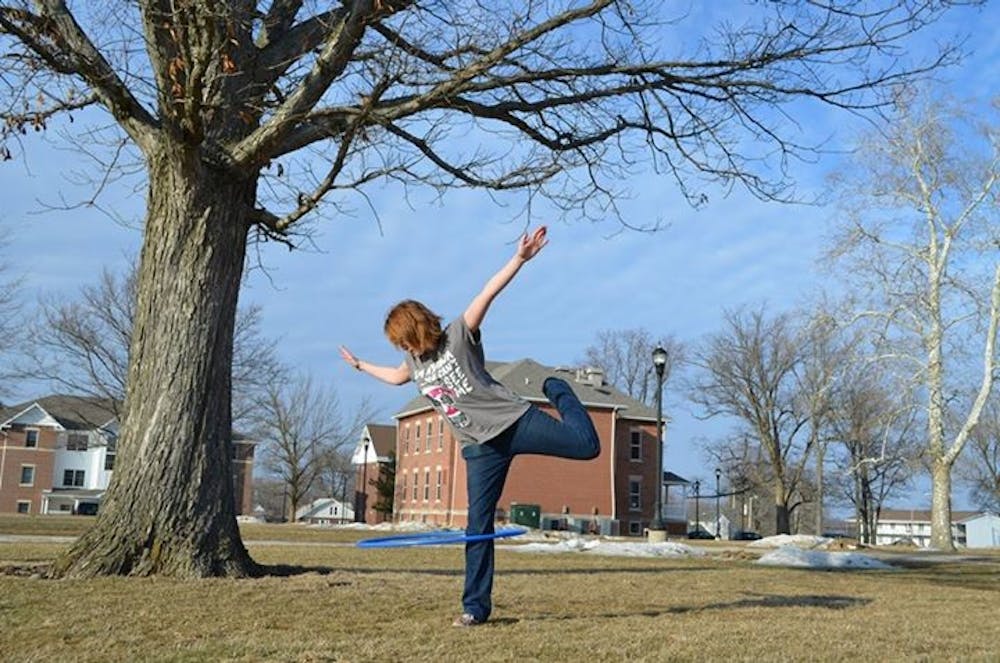By Elizabeth Syson | Echo
Most people see hula-hoops as children's toys, but Gabbi Cunningham considers them an artistic medium. Most people can twirl a hula-hoop around the waist-Cunningham dances in and out of the hoop, spinning it on her arms, legs and neck often in rhythm to music, turning a childhood pastime into freeform dance.
"They were like, 'What is wrong with you?' But they got me one from Walmart anyway, and that's how it started," she said. With nobody to teach her, she taught herself from YouTube tutorials.
She said rhythm is the most difficult aspect for her-she has no sense of rhythm, an integral part of hooping. Hours of practice, however, have paid off. Although she said she does not follow any specific practice routine, when she does practice, she works for at least an hour at a time.
When asked what she loves about hooping, Cunningham said, "There's always something new to learn. You can do it with fire. You can do it in the dark. You can do it to awesome rave music."
The hooper community also inspires her. Although she knows of nobody else at Taylor who hoops, she is a part of a large online community, including Unity of the Hula Hoopers, a Facebook group of over 11,000 members that she began and administrates. This community includes a diverse array of people who share videos, stories and trick tutorials with each other. They also participate in festivals, such as Mini Flow Fest 2014, where Cunningham recently attended workshops to learn new tricks and techniques.
Hooping is a fun form of physical exercise that builds up stamina and muscle control, but it can also benefit mental health. For Cunningham, who has struggled with depression and bulimia nervosa, hooping provides both an emotional boost and motivation to continue recovering.
She also uses her hooping as a way to encourage others in their personal struggles. One way she pursues this is through a second Facebook groups she runs, which focuses on mental health and welcomes even individuals who do not hoop. This year her Facebook group also held a calendar contest and donated the proceeds to World Hoop Day, a non-profit organization that provides hula-hoops to underprivileged children around the world in an effort to improve mental and physical wellness and encourage healthy recreation.
Cunningham's dedication to hooping has caught the attention of Hoop Conscious, a small hula-hoop company that recently chose her as one of four sponsored hoopers. This sponsorship, which offers her greater exposure and recognition from the hooping community as well as discounts on Hoop Conscious products, is based on both Cunningham's skill and her involvement in running online hooper groups.
In the future, Cunningham hopes to standardize an annual charity donation through her online groups and then turn over active administration to someone else so that she can focus more on her art. She wants to attend graduate school and become an illustrator, but she intends to continue her involvement with hooping and hopes to try street performing at some point.
For now, she continues hosting four Facebook groups for hoopers, and practices in her spare time.
"Usually in the laundry room!" she said when asked where she goes to practice hooping at Taylor. "There's plenty of space, hardly any people-I did knock down the light fixture once and had to put it back up."
She encourages others to try the art form that has captured her heart. Apart from the purchase of hula-hoops, which can be as low as $20 or as high as $400, depending on the type and quality of the hoop, the hobby is inexpensive. Though it requires practice and dedication, Cunningham says it takes less time than one might expect, and it offers wide variety in technique and performance. She recommends that beginners start with large, heavy hoops until they have developed the muscle control necessary for controlling lighter hoops. Especially in a stressful environment like college, she believes that hooping can provide a fun, healthy hobby.



